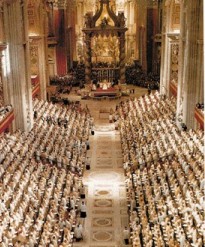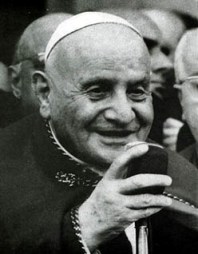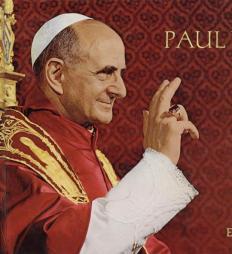V2, We Love You: Introduction
 As I mentioned in a previous post, I’m planning on offering a series of blog entries about the “Ecumenical Council” commonly known as “The Second Vatican Council”, or simply “Vatican 2”.
As I mentioned in a previous post, I’m planning on offering a series of blog entries about the “Ecumenical Council” commonly known as “The Second Vatican Council”, or simply “Vatican 2”.
Most Catholics will be able to tell you that Vatican 2 was important, but, in my experience, fairly few are actually able to articulate well why it was important. Many are not able to explain what exactly Vatican 2 was, what it actually taught and why it is important in the history of the Catholic Church. It is my hope that this blog will help shed a little light on these issues.
I think that it is best, before I get stuck into the meat of Vatican 2, that I attempt to give something of a general introduction to the concept of councils in general, and ecumenical councils in particular.
21st Ecumenical Council
The Second Vatican Council was the 21st Ecumenical Council in the 2,000 year history of the Catholic Church. This, of course, begs the question: “David, what’s an Ecumenical Council?”
I’m glad you asked 
As I mentioned in a previous post the word “ecumenical” comes from the Greek word “oikoumene” (οἰκουμένη), which literally means “that which pertains to the whole inhabited world” and its use is even found in Sacred Scripture:
“And this gospel of the kingdom will be preached in the whole world as a testimony to all nations” – Matthew 24:14
The word “ecumenical” is often used in reference to the Christian Unity, but for the purpose of this blog post I’m using it with specific reference to Church Councils.
Biblical Prototype
The purpose of Church councils is usually to settle matters of doctrine and practice. We see a prototype for this in the Acts of the Apostles, Chapter 15 at the “Council of Jerusalem”:
Some men came down from Judea to Antioch and were teaching the brothers: “Unless you are circumcised…you cannot be saved.” This brought Paul and Barnabas into sharp dispute and debate with them. So Paul and Barnabas were appointed, along with some other believers, to go up to Jerusalem to see the apostles and elders about this question…The apostles and elders met to consider this… – Acts 15:1-2, 6
So, as we can see, there was a dispute in the Early Church as to whether or not circumcision was necessary for salvation. How did they decide to settle the matter? Contrary to what many Christians today would advocate, they didn’t send everyone home to read the Bible and decide for themselves. No, they went to those with authority, to the apostles and elders in Jerusalem who convened a council to settle the question:
After much discussion, Peter got up and addressed them: “Brothers, you know that some time ago God made a choice among you that the Gentiles might hear from my lips the message of the gospel and believe….He made no distinction between us and them, for he purified their hearts by faith. Now then, why do you try to test God by putting on the necks of the disciples a yoke that neither we nor our fathers have been able to bear? No! We believe it is through the grace of our Lord Jesus that we are saved, just as they are.” – Acts 15:7-11
The decision of the council was to produce a document, a letter:
The apostles and elders, your brothers, To the Gentile believers in Antioch, Syria and Cilicia: Greetings. We have heard that some went out from us without our authorization and disturbed you, troubling your minds by what they said. So we all agreed to choose some men and send them to you with our dear friends Barnabas and Paul— men who have risked their lives for the name of our Lord Jesus Christ. Therefore we are sending Judas and Silas to confirm by word of mouth what we are writing. It seemed good to the Holy Spirit and to us not to burden you with anything beyond the following requirements: You are to abstain from food sacrificed to idols, from blood, from the meat of strangled animals and from sexual immorality. You will do well to avoid these things. Farewell – Acts 15:23-29
With this letter they sent back some representatives to Antioch (today we would call these people “Papal Legates”) and we are told that the letter was delivered and “The people read it and were glad to its encouraging message” (Acts 15:31).
This was the prototype for the Ecumenical Councils which would be convened in the coming centuries. The leaders of the Church would gather, deliberate, declare the truth and propagate it to the rest of the Church.
By whom was the Council called?
In an unexpected move, less than three months after being elected to the Chair of St. Peter, John XXIII (23rd) announced his intention to call an Ecumenical Council, saying that he wanted to:
“…open the window of the Church to let in some fresh air” – Pope John XXIII
He sent out letters to all the bishops of the world asking them what issues and problems they felt the Council needed to address and this set the agenda. This was the first council in Church history which wasn’t called to directly address some form of heresy.
This was a time of great social, political and economic upheaval. In fact, in 1869, the previous Ecumenical Council (now known as “Vatican 1”) had been cut short due to political upheaval in Italy.
The Second Vatican Council was opened in 1962 with 2,100-2,300 bishops in attendance, together with official observers from Protestant and Eastern Orthodox churches, including representatives from the community very close to my own heart, the monks of Taizé.
The council came to a conclusion three years later in 1965. Pope John XXIII had died during this time so it was his successor Paul VI (6th) who actually brought the Council to a close. The question is, though, what did they actually spend their time doing?!
The Teaching of Vatican 2
The teaching of Vatican 2 can be found in the 16 documents that the Council produced (remember the letter from the Council of Jerusalem?). These documents are grouped by their level of importance:
1. Constitutions
“Dei Verbum” (Dogmatic Constitution on Divine Revelation)
“Lumen Gentium” (Dogmatic Constitution on the Church)
“Gaudium et Spes” (Pastoral Constitution on the Church in the Modern World)
“Sacrosanctum Concilium” (Constitution on Sacred Liturgy)
2. Decrees
“Ad Gentes” (Mission Activity)
“Apostolicam Actuositatem” (Lay People)
“Christus Dominus” (Bishops in the Church)
“Inter Mirifica” (Social Communication)
“Optatam Totius” (Priestly Training)
“Orientalium Ecclesiarum” (Eastern Churches)
“Perfectae Caritatis” (Renewal of Religious Life)
“Presbyterorum Ordinis” (Life of Priests)
“Unitatis Redintegratio” (Ecumenism)
3. Declarations
“Dignitatis Humanae” (Religious Freedom)
“Gravissimum Educationis” (Christian Education)
“Nostra Aetate” (Relations with Non-Christians)
This is quite a significant library of writings! Rather than going through all of them, I will blog about a subset of these documents to hopefully present a rough picture of the teaching from the Council.
In the meantime, I can thoroughly recommend the videos by Vic Scaravilli from the Catholic Digital Studios:
Next time, I’ll be looking at the document “Dei Verbum”…

